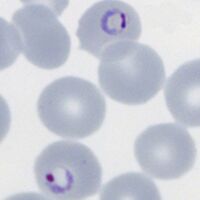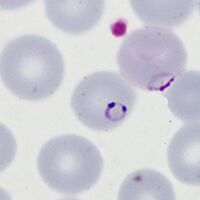P.falciparum early trophozoites gallery: Difference between revisions
From haematologyetc.co.uk
No edit summary |
No edit summary |
||
| (17 intermediate revisions by 2 users not shown) | |||
| Line 1: | Line 1: | ||
---- | ---- | ||
'''Navigation'''</br> | '''Navigation'''</br> | ||
[[Plasmodium falciparum: Morphology|Go Back]] | |||
---- | ---- | ||
{| class="wikitable" style="border-style: solid; border-width: | {| class="wikitable" style="border-style: solid; border-width: 4px; color:black" | ||
|colspan="1" style = "font-size:100%; color:black; background: # | |colspan="1" style = "font-size:100%; color:black; background: FFFAFA"|<span style="color:black> | ||
{| class="wikitable" style="border-style: solid; border-width: 0px; border-color: #023020; color:black" | |||
|colspan="1" style = "font-size:100%; color:black; background: CBD5CO |'''''P.falciparum'' gallery of early trophozoites''''' | |||
|} | |} | ||
---- | |||
<span style="font-size:95%">''' ''P.falciparum'' '''</span></br> | |||
<span style="font-size:95%">Small delicate rings, within red cells of normal (or slightly crenated) appearance.</br>These may be the only forms seen in some patients at diagnosis.</br>Some parasite forms are typical though not exclusive of the species, these include: accolé forms, double chromatin dot forms, and multiple parasites within infected red cells. | |||
<gallery mode="traditional" widths=200px heights=200px> | |||
File:PFET1g.jpg|<span style="font-size:80%">Fine ring form</span>|link={{filepath:PFET1g.jpg}} | |||
<gallery mode="traditional" widths= | File:PFET2g.jpg|<span style="font-size:80%">Double dot form and normal ring</span>|link={{filepath:PFET2g.jpg}} | ||
File: | File:PFET3g.jpg|<span style="font-size:80%">Accolé and double dot forms</span>|link={{filepath:PFET3g.jpg}} | ||
File: | File:PFET4g.jpg|<span style="font-size:80%">Multiple parasite form</span>|link={{filepath:PFET4g.jpg}} | ||
File: | </gallery> | ||
File: | |||
</gallery> | |||
---- | ---- | ||
Latest revision as of 09:39, 4 June 2024
Navigation
Go Back
P.falciparum |



